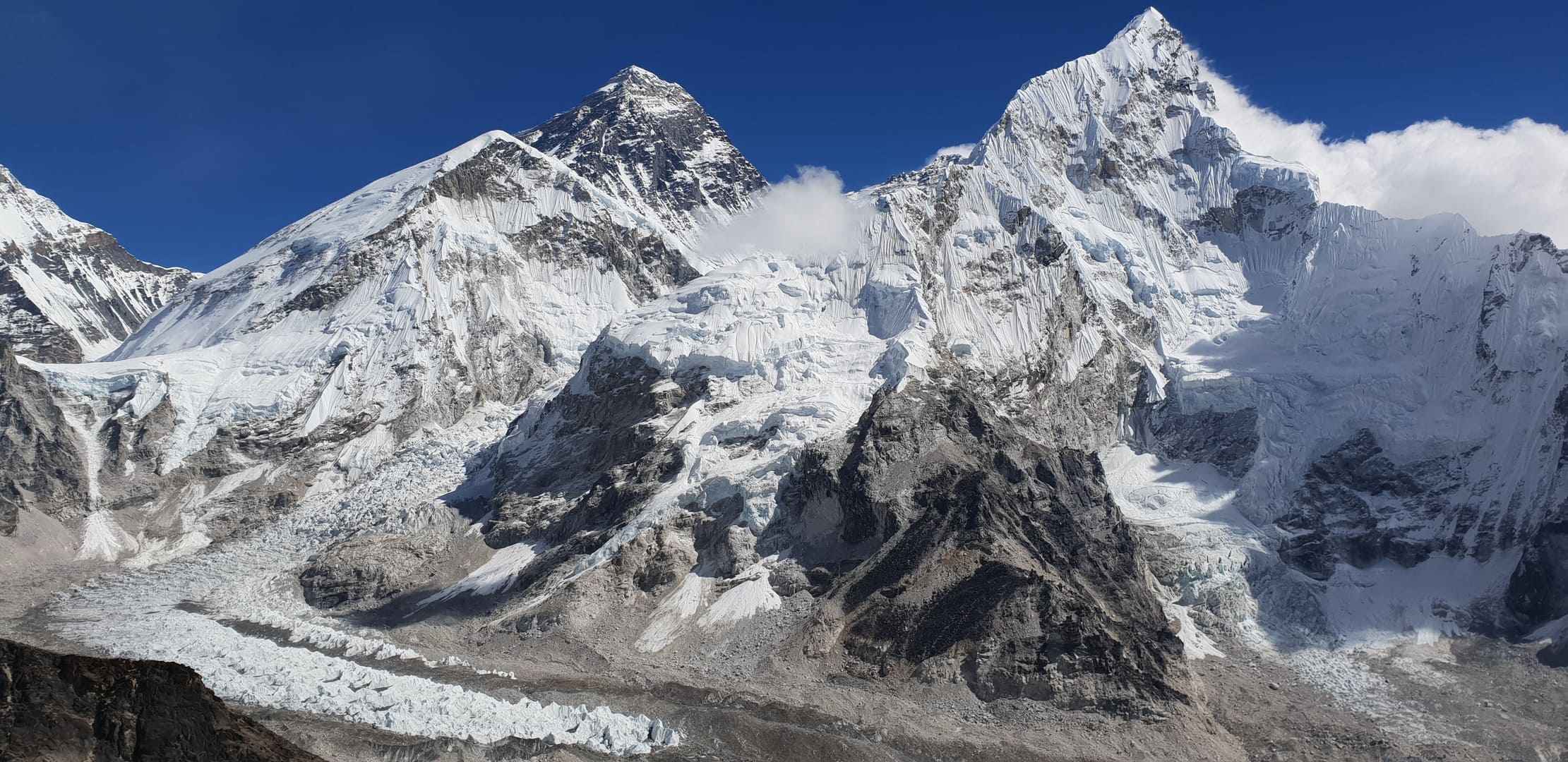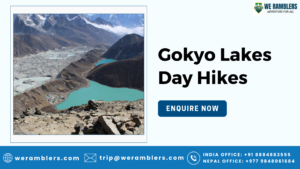Sagarmatha National Park: A Natural Wonder of Nepal
Sagarmatha National Park: An Overview
Sagarmatha National Park, nestled in the Himalayan region of Nepal, is a UNESCO World Heritage Site known for its breathtaking landscapes and cultural significance. The park is home to Mount Everest, the world’s highest peak, and offers awe-inspiring views of snow-capped mountains, glaciers, and valleys. Spanning an area of 1,148 square kilometers, the park is an adventurer’s paradise, attracting trekkers, mountaineers, and nature enthusiasts from across the globe.
Established in 1976, the park is also recognized for preserving the traditions and culture of the Sherpa community, who live harmoniously with the pristine environment. Rich biodiversity, including endangered species such as the snow leopard and red panda, adds to its ecological importance. A Sagarmatha National Park trip with We Ramblers provides visitors with a unique opportunity to experience the natural wonders of the Himalayas and the vibrant heritage of the local Sherpa people.
Sagarmatha National Park Location, Geography, and Altitude
Located in the Solu-Khumbu district of Nepal, Sagarmatha National Park location lies northeast of Kathmandu. This remarkable park is part of the Himalayan Mountain range and encompasses diverse terrains, including deep valleys, glaciers, and towering peaks.
The Sagarmatha National Park altitude varies significantly, ranging from 2,845 meters at the lower elevations to 8,849 meters at the summit of Mount Everest. This dramatic range creates varied ecosystems and landscapes, from dense forests and meadows to barren alpine terrain and icy slopes.
The region is also home to the famous Dudh Koshi and Bhote Koshi rivers, which add to the park’s scenic beauty. Several iconic peaks, including Nuptse, Lhotse, and Ama Dablam, form the backdrop of the park, making it a visually stunning destination. The location and geography of the park make it a haven for trekking, climbing, and exploring nature.
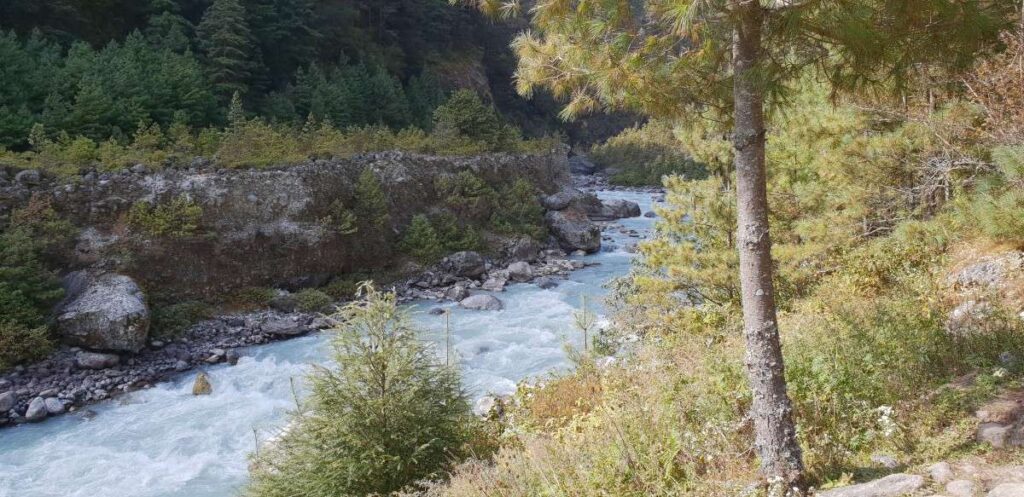
Sagarmatha National Park People and Culture
The people and culture add depth to Sagarmatha National Park’s natural beauty. The region is home to the Sherpa community, known for their resilience, rich traditions, and strong connection to the mountains. The Sherpas have lived in the harsh Himalayan environment for centuries, adapting to the challenging conditions with remarkable strength and spirit.
The Sherpa Community
Sherpas are world-renowned for their mountaineering skills. Many works as guides and porters, assisting trekkers and climbers who venture toward Mount Everest. Their knowledge of the rugged terrain and high-altitude expertise has made them an essential part of Everest expeditions.
Culture and Traditions
The culture in Sagarmatha National Park is deeply influenced by Tibetan Buddhism. Monasteries, prayer flags, and chortens (stupas) are common sights along trekking routes. The famous Tengboche Monastery, perched on a hilltop with stunning views of Everest, is a spiritual center for the local people.
Sherpas celebrate traditional festivals like Mani Rimdu, featuring colorful dances, rituals, and masked performances that reflect their spiritual beliefs. Their warm hospitality, simple way of life, and deep respect for nature create an enriching cultural experience for visitors exploring the park.
Villages, Towns, and Monasteries in Sagarmatha National Park
Sagarmatha National Park is dotted with picturesque villages, bustling towns, and ancient monasteries that reflect the region’s rich cultural heritage. These settlements offer insight into the daily lives of the Sherpa people and serve as key resting points for trekkers.
Villages and Towns
Namche Bazaar is the most famous town in the park. Often called the “Gateway to Everest,” it is a vibrant hub with lodges, shops, cafes, and markets. Trekkers stop here to acclimatize and enjoy stunning views of Everest and surrounding peaks.
Khumjung is a peaceful village near Namche, known for its traditional stone houses and the Khumjung Monastery, which houses a relic said to be a Yeti scalp. Phortse and Pangboche are other notable villages, offering breathtaking mountain views and a glimpse into Sherpa life.
Monasteries
The Tengboche Monastery is the largest and most significant monastery in the region. It stands at 3,867 meters, offering panoramic views of Everest, Ama Dablam, and Lhotse. Trekkers often visit to witness Buddhist ceremonies and soak in the spiritual ambiance.
Khumjum monastery is another notable monastery in the area. The monastery also houses monks who reside there to study and practice Buddhism. The Khumjung monastery has stunning architecture and houses the legendary Yeti skull.
Pangboche monastery is another of the region’s oldest monasteries, and it houses numerous monks and Buddhist students. You can locate Yeti’s hand in this monastery.
These villages and monasteries not only offer rest and cultural experiences but also showcase the harmony between the Sherpa people and the majestic Himalayas.
How to Reach Sagarmatha National Park
Reaching Sagarmatha National Park from Kathmandu is an exciting journey. The park is accessible by both air and road, with options to suit different preferences.
Reaching Sagarmatha National Park by Air
The quickest way to reach the park is by taking a 30-minute flight from Kathmandu to Lukla. This short flight offers spectacular views of the Himalayan range. Lukla serves as the starting point for most trekking routes into the park. From Lukla, trekkers can follow well-marked trails to key destinations like Namche Bazaar and Everest Base Camp.
Reaching Sagarmatha National Park by Road
For those seeking a longer journey, traveling by road is an alternative. Visitors can drive from Kathmandu to Jiri or Salleri, which are starting points for trekking routes to the park. This option adds a cultural dimension, allowing visitors to explore local villages and enjoy the scenic countryside.
The Sagarmatha National Park Adventure distance from Kathmandu to Lukla is about 350 kilometers. Road travel and trekking combined take longer than flying, but the journey offers an authentic experience of Nepal’s rural charm. Whichever route you choose, reaching the park is an adventure in itself and sets the stage for exploring its natural wonders.
Best Time to Visit Sagarmatha National Park
The Sagarmatha National Park climate varies greatly depending on altitude and time of year. The ideal time for a Sagarmatha National Park trip is during the autumn and spring seasons, which offer the best weather and trekking conditions.
Best Time for Trekking in Sagarmatha National Park
The time between October and November is the most popular for visiting the park. Clear skies, mild temperatures, and stunning views of the mountains make it the perfect time for trekking. Trails are bustling with trekkers, and the weather remains stable throughout this period.
Spring and Summer (March to May) are other excellent times to visit. Rhododendrons bloom along the trails, adding vibrant colors to the scenery. The weather is moderate, making it comfortable for outdoor activities.
Sagarmatha National Park Adventure in Nepal During Winters
Winter (December to February) is less crowded but suitable for those who love snow-covered landscapes. However, temperatures drop significantly, especially at higher altitudes, so visitors must prepare for the extreme cold.
Plan your Sagarmatha National Park tour based on your interests and weather preferences. Autumn and spring are ideal for trekking, while winter offers a peaceful experience for those prepared for the cold. Monsoon (May to September) is the least favorable time due to heavy rainfall, which makes trails slippery and limits visibility.
Sagarmatha National Park Entry Fee and Timings
Visitors to the park must obtain a Sagarmatha National Park permit to enter. The Sagarmatha National Park Entry Fee depends on nationality:
- Sagarmatha National Park Entry Fee for Foreign nationals: NPR 3,000 per person
- Sagarmatha National Park Entry Fee for SAARC nationals: NPR 1,500 per person
- Sagarmatha National Park Entry Fee for Nepali citizens: NPR 100 per person
In addition to the park entry fee, trekkers require a TIMS (Trekkers’ Information Management System) card, which costs NPR 2,000 for individual trekkers and NPR 1,000 for group trekkers. Currently TIMS is not mandatory for Sagarmatha, but it can be applicable anytime, you can check it before planning to visit.
You also need Khumbu Nagar Palika permit to enter Sagarmatha National Park, It cost, NPR. 2000 for SAARC citizens, and NPR. 3000 for other nationalities.
The park is open throughout the year, and most trekking routes operate during daylight hours. Visitors are advised to carry their permits at all times, as they may be checked at various points along the trails. Timings are flexible, but starting early in the day is recommended to make the most of the daylight and avoid afternoon weather changes.
Places to Visit in Sagarmatha National Park: Lakes, Glaciers, Mountains & Rivers
Sagarmatha National Park adventure tours offer a range of activities and attractions for adventure lovers and nature enthusiasts. You can enjoy breathtaking views of towering mountains, pristine lakes, vast glaciers, and rushing rivers. Each landmark tells a story of the park’s rich geography and diverse ecosystem. Here are the must-visit places within the park:
Mountains
The Sagarmatha National Park is world-famous for its majestic tallest peaks, attracting trekkers and climbers from around the globe
Mount Everest (8,849 meters)
The crown jewel of the park, Mount Everest, is the tallest mountain on Earth. Trekkers can reach Everest Base Camp to witness its towering presence up close. The view of Everest from Kala Patthar is unforgettable.
Mount Lhotse (8,516 meters)
Located just south of Everest, Lhotse is the fourth-highest mountain in the world. Its icy slopes are dramatic, and trekkers can view it along the Everest Base Camp route.
Mount Cho Oyu (8,188 meters)
Cho Oyu, the world’s sixth-highest mountain at, is seen from the Gokyo zone.
Mount Gyachung Kang (7,952 meters).
Gyachung Kang, the highest peak in the 7000-meter range and the 15th highest mountain on our planet, is visible from the Gokyo zone.
Mount Pumori (7,165 meters)
Another magnificent peak in the Sagarmatha zone, this one can be seen from Gorakhshep and Kalapatthar, just opposite the Everest.
Mount Nuptse (7,861 meters).
Another 7000-meter monster in the Sagarmatha National Park, Nuptse, is only 2 kilometers from Everest; you can enjoy the vast panorama from Lobuche, Gorakshep, and Kalapatthar.
Ama Dablam (6,812 meters)
Often called the “Matterhorn of the Himalayas,” Ama Dablam is one of the most beautiful peaks in Nepal. Its sharp ridges and soaring spires dominate the landscape, making it a favorite for photographers and climbers.
Sagarmatha National Park is home to the world’s largest mountains. This park contains three 8000-meter peaks, including the world’s highest peak, Mount Everest, followed by Lohtse (number four) and Cho Oyu (number six).
Sagarmatha National Park contains seven 7000-meter peaks: Baruntse, Nuptse, Pumo Ri, Gyachung Kang, Nangpai Gosum, Pasang Lhamu Chuli, and Shartse.
Sagarmatha National Park contains more than 25 6000-meter-high mountains, the most renowned of which are Ama Dablam, Island Peak, Lobuche Peak, Thamserku, Kongde, and Kusum Kangaru.
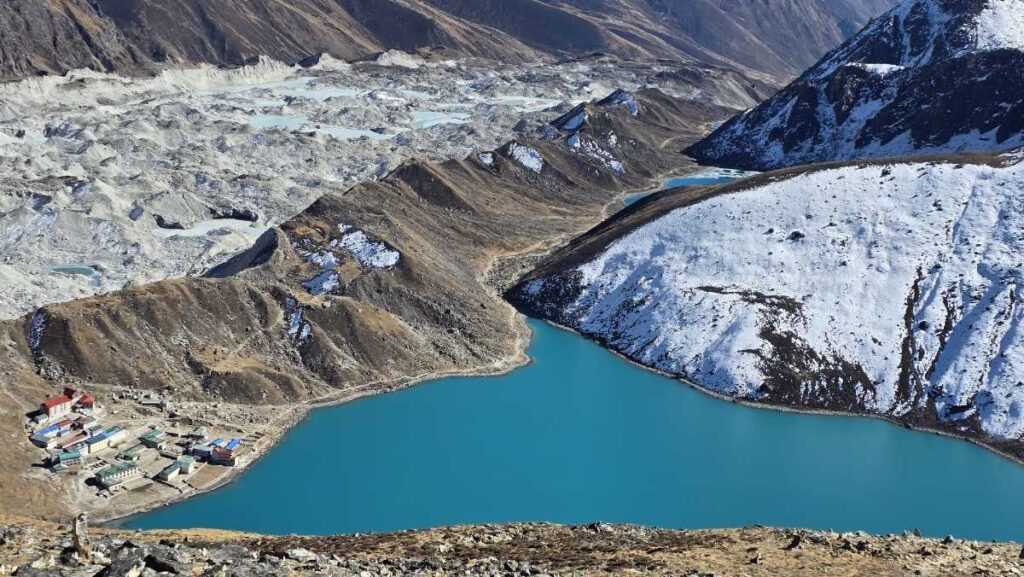
Lakes
Sagarmatha National Park is home to stunning glacial lakes that add a splash of vibrant blue amidst the snow-capped peaks.
Gokyo Lakes
The Gokyo Lakes are a group of high-altitude freshwater lakes, considered sacred by both Hindus and Buddhists. The turquoise waters reflect the surrounding mountains, creating perfect picture scenery. Trekkers often hike to Gokyo Ri for panoramic views of the lakes and Everest.
Imja Tsho
This glacial lake near Island Peak has formed due to melting glaciers. Although beautiful, it serves as a reminder of climate change impacts in the Himalayas. Its icy-blue water contrasts with the rocky terrain around it.
Chola Lake
Another beautiful lake near Thukla and Dzongla, Chola Lake provides one of the stunning views of mount Ama Dablam.
Glaciers in Sagarmatha National Park
The Sagarmatha National park’s glaciers are not just scenic wonders but also vital sources of water for the region.
Khumbu Glacier
This iconic glacier stretches down from Everest, carving through rugged terrain. It is the highest glacier in the world and a key part of the Everest Base Camp trek. The icefall section near Base Camp is both awe-inspiring and dangerous, with towering ice seracs and deep crevasses.
Ngozumpa Glacier
The longest glacier in the Himalayas, Ngozumpa lies near the Gokyo Lakes. Its rocky, ice-covered expanse offers a dramatic landscape, and trekkers cross parts of it when heading to Gokyo Ri.
Imja Glacier
Located near Island Peak, Imja Glacier feeds into Imja Tsho. Its striking ice formations and rugged beauty make it a fascinating site to explore during high-altitude treks.
Nangpai Gosum Glacier
Also known as Nangpa glacier, is another big glacier in Sagarmatha National Park, this glacier is the source of the Bhote Koshi River, which is a major river in the national park.
Rivers in Sagarmatha National Park
The fast-flowing rivers in Sagarmatha National Park originate from glacial melt, carving deep valleys and nourishing the region’s ecosystem.
Dudh Koshi River
Meaning “Milk River” in Nepali, the Dudh Koshi gets its name from its milky white waters caused by glacial silt. Trekkers cross several suspension bridges over this river, adding adventure and excitement to their journey. This river originates from the Ngozumpa Glacier and the Gokyo Lakes.
Bhote Koshi River
Flowing from Tibet into Nepal, the Bhote Koshi is a powerful river with crystal-clear water. Its rapid currents and scenic gorges make it a striking feature along the trekking routes. This river originates from the Nangpa glacier.
Lobuche River
Also known as the Imja River, Imja Khola, or Lobuche Khola. The river originates from the Khumbu glacier near Thukla to the Imja River after Pheriche and then into the Dudh Koshi River near Phungi Thanga. The Imja River, which flows from the Imja Glacier, connects with the Lobuche River at Pheriche.
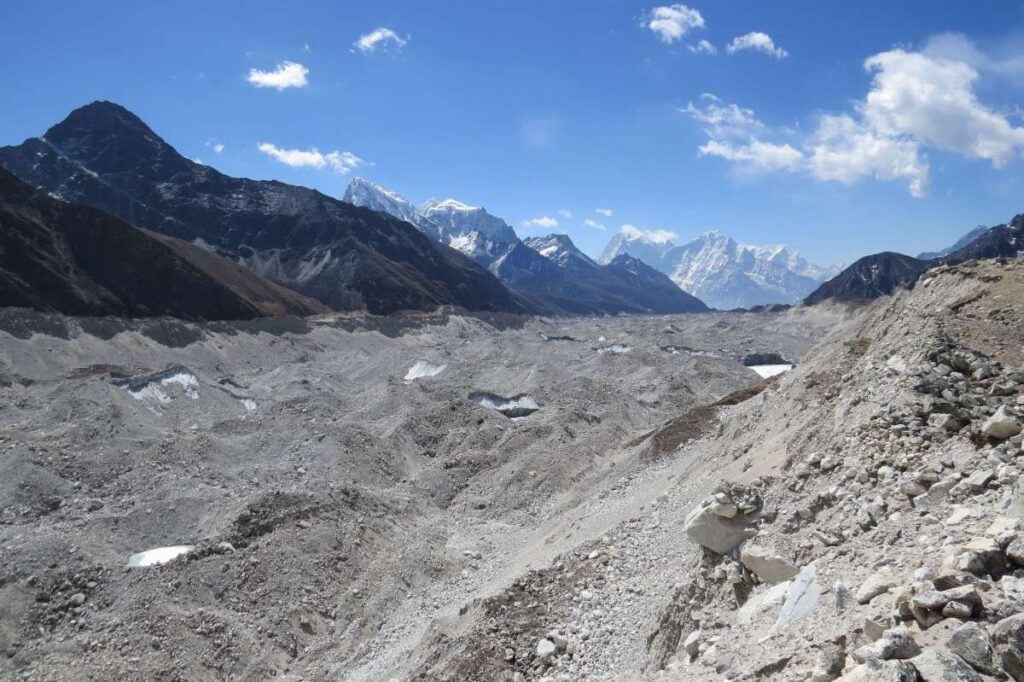
Other Important Spots in Sagarmatha National Park to Explore
Kala Patthar
Known for the best panoramic view of Mount Everest, Kala Patthar is a must-visit spot. The sunrise and sunset views from here are breathtaking, offering a golden glow over the snow-capped peaks.
Gokyo Ri
Gokyo Ri is located near Gokyo village and next to the largest Gokyo lake. It is noted for its breathtaking view of four 8000-meter mountains (Cho Oyu, Everest, Lhotse, and Makalu) in a 180-degree line.
Chhukung Ri
Chhukung Ri, like Kalapatthar and Gokyo Ri, is a trekking peak located near Chukung Village. Chukung Ri offers excellent views of Lhotse (particularly the Lhotse wall), Makalu, Sharitse, Island Peak, Ama Dablam, and the entire Imja valley.
Everest Viewpoint (Hotel Everest View)
Situated near Namche Bazaar, this viewpoint offers spectacular views of Everest without the need for a strenuous trek. It’s perfect for those with limited time who still want to witness the grandeur of the Himalayas.
Mountain Climbing in Sagarmatha National Park
Mountain climbing in Sagarmatha National Park offers an unparalleled adventure for thrill-seekers. The park is home to legendary peaks like Mount Everest, Ama Dablam, Lhotse, and Taboche, attracting climbers from around the world. Climbers face challenging terrains, extreme altitudes, and harsh weather conditions, making it a true test of endurance and skill. Expeditions often start from Lukla, with acclimatization stops in villages like Namche Bazaar. Alongside breathtaking views, climbers experience the rich Sherpa culture and spiritual landmarks, such as Tengboche Monastery. Whether summiting Everest or tackling lesser-known peaks, each climb in Sagarmatha National Park promises an unforgettable Himalayan adventure.
Most Popular Treks in Sagarmatha National Park
Sagarmatha National Park offers some of the most thrilling and scenic trekking routes in the world. Each trek showcases breathtaking mountain views, diverse landscapes, and rich Sherpa culture. Here are three popular treks that attract adventurers from around the globe:
Everest Base Camp Trek
The Everest Base Camp trek is the most iconic trekking route in the park. It takes you through vibrant Sherpa villages, dense forests, and rugged trails, all leading to the base of the world’s tallest mountain, Mount Everest. Starting from Lukla, the trek passes through Namche Bazaar, Tengboche Monastery, and Dingboche before reaching Everest Base Camp at an altitude of 5,364 meters. Highlights include panoramic views from Kala Patthar, the mighty Khumbu Glacier, and stunning sunrises over Everest. This trek offers an unforgettable blend of natural beauty and cultural experiences.
Three Passes Trek
The Three Passes trek is a challenging adventure for those seeking rugged trails and high-altitude thrills. It covers three major mountain passes: Kongma La (5,535 m), Cho La (5,420 m), and Renjo La (5,360 m). This circuit trek offers dramatic views of Everest, Lhotse, Makalu, and Cho Oyu. Along the way, you’ll explore remote villages, cross glaciers, and visit Gokyo Lakes. The trek is physically demanding but rewards trekkers with breathtaking landscapes and fewer crowds compared to the Everest Base Camp route.
Gokyo Lakes Trek
The Gokyo Lakes trek is perfect for those who want to explore stunning glacial lakes and avoid the busier Everest Base Camp trail. The trek leads to the mesmerizing Gokyo Lakes, a series of high-altitude freshwater lakes with vibrant turquoise waters. The climb to Gokyo Ri (5,357 m) offers one of the best panoramic views of Mount Everest and the surrounding peaks. Trekkers also get to witness the impressive Ngozumpa Glacier, the largest glacier in the Himalayas. This trek combines natural beauty with a peaceful, less crowded experience.
Sagarmatha National Park Flora and Fauna
Sagarmatha National Park boasts a rich variety of flora and fauna, shaped by its diverse altitudes and unique climate. The park’s landscapes range from dense forests to alpine meadows and barren rocky terrains, each supporting different plant and animal species.
Flora
The vegetation changes as you move to higher elevations. In the lower regions, you’ll find lush forests filled with pine, hemlock, fir, birch, and rhododendron trees. During spring, rhododendrons bloom in vibrant shades of red, pink, and white, adding color to the trails. As the altitude increases, forests give way to shrublands, mosses, and lichens. At the highest points, where conditions are harsh, only hardy grasses and small alpine plants survive.
Fauna
The park is equally rich in wildlife. Sagarmatha National Park animals include rare and endangered species. The elusive snow leopard roams the higher regions, while Himalayan tahrs and musk deer are commonly spotted in the rugged terrains. Red pandas, Himalayan black bears, and langurs inhabit the forests. Bird lovers can spot colorful species like the Himalayan monal (Nepal’s national bird), blood pheasants, and snowcocks.
This incredible biodiversity makes the Sagarmatha National Park adventure not just a trekking paradise but also a haven for nature enthusiasts eager to explore its thriving ecosystem.
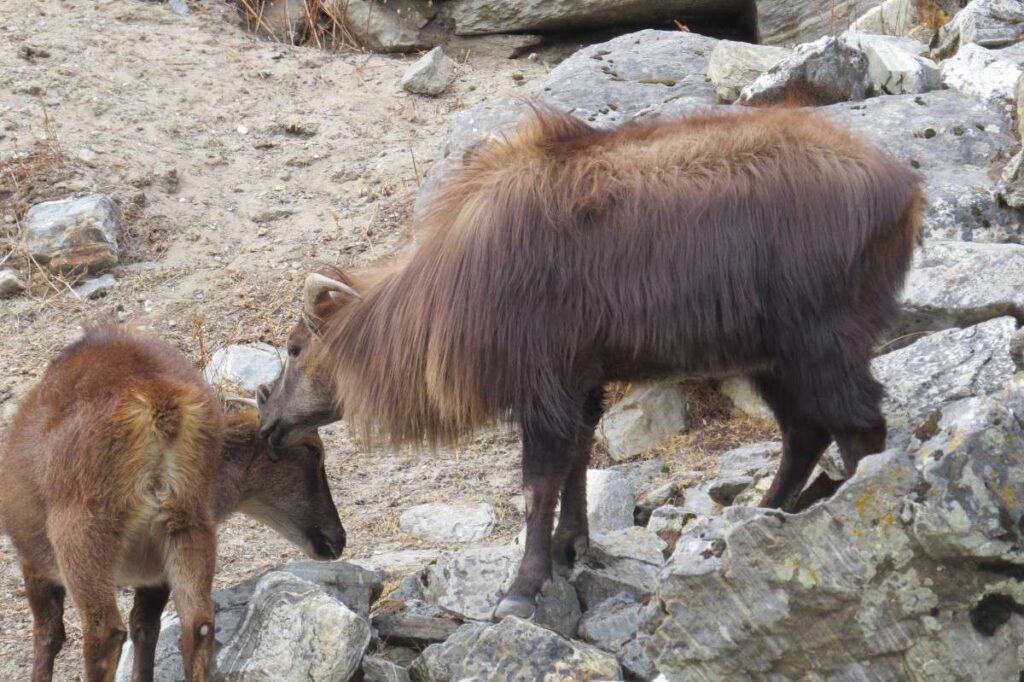
Sagarmatha National Park Adventure Accommodation: Places to Stay
Accommodation options in the park cater to various budgets and preferences. Sagarmatha National Park adventure accommodation includes teahouses, lodges, and guesthouses along trekking routes.
Teahouses are basic yet comfortable, offering simple meals and cozy rooms. These are the most common accommodations for trekkers. For a more comfortable stay, lodges in places like Namche Bazaar provide additional amenities, including hot showers and Wi-Fi.
Luxury trekkers can opt for higher-end lodges that offer premium facilities and better comfort. Staying at these locations allows visitors to rest and rejuvenate after a day of trekking. Booking in advance is advisable, especially during peak trekking seasons.
Sagarmatha National Park Map
A map is essential for navigating the region. It highlights trekking routes, key attractions, and villages within the park. Sagarmatha National Park maps are available in Kathmandu or Namche Bazaar and can guide travelers effectively.
Carrying a map ensures a safe and organized journey. It also helps with planning trekking days and locating places of interest, such as Everest Base Camp, Gokyo Lakes, and Kala Patthar. A map is an invaluable tool for anyone exploring the park.
Sagarmatha National Park FAQs
Why is Sagarmatha National Park famous for?
Sagarmatha National Park is famous for being home to Mount Everest, the world’s highest peak. It also boasts amazing landscapes, including glaciers, lakes, and diverse flora and fauna. The park’s cultural significance, being inhabited by the Sherpa community and hosting sacred monasteries, makes it a popular destination for trekkers, mountaineers, and nature lovers alike.
How do I go to Sagarmatha National Park from Kathmandu?
To reach Sagarmatha National Park from Kathmandu, you need to take a flight from Kathmandu to Lukla, which is the main gateway to the park. From Lukla, you can trek through beautiful villages like Namche Bazaar, Tengboche, and Dingboche, gradually ascending to higher altitudes, all while soaking in the stunning Himalayan views.
What is the height of Sagarmatha National Park?
Sagarmatha National Park spans a range of altitudes, from about 2,740 meters (8,989 feet) at Jorsale to 8,849 meters (29,032 feet) at Mount Everest. The park’s varying elevations give it a unique climate and ecosystem, supporting everything from lush forests to barren, icy landscapes at its highest points.
What is the climate in Sagarmatha National Park?
The Sagarmatha National Park climate varies significantly with altitude. At lower elevations, you’ll find temperate weather with warm summers and cool winters. As you ascend, temperatures drop, and the weather becomes harsher, with cold winters and short summers. The higher regions, especially near Everest, experience freezing temperatures year-round, with snow and heavy winds during the winter months.
What is the culture of Sagarmatha National Park?
The culture of Sagarmatha National Park is deeply influenced by the Sherpa community, who have lived in the region for centuries. Their traditions, customs, and Buddhist beliefs shape the park’s unique culture. Monasteries, stupas, and prayer flags dot the landscape, reflecting their spiritual life. Sherpa festivals, like Mani Rimdu, feature traditional dances and ceremonies, offering trekkers a glimpse into their rich cultural heritage.
What are the endangered animals in Sagarmatha National Park?
Sagarmatha National Park is home to several endangered species. The snow leopard, known for its elusive nature, roams the park’s rugged terrain. The red panda, Himalayan tahr, and musk deer also inhabit the park. Conservation efforts are crucial, as these animals face threats from habitat loss, poaching, and climate change, making Sagarmatha a vital sanctuary for their survival.
Book a Sagarmatha National Park Holiday Trip
Book a Sagarmatha National Park tour with We Ramblers for a hassle-free adventure. We offer packages that include permits, guides, and accommodation. Choose an expedition plan that aligns with your budget and preferences.
An organized tour saves time and allows you to focus on enjoying the beauty of the park. Whether trekking to Everest Base Camp or exploring the vibrant culture of the Sherpa community, a guided holiday trip guarantees a memorable experience in the heart of the Himalayas. If you want to explore our different packages or learn more about our services, contact us today.

